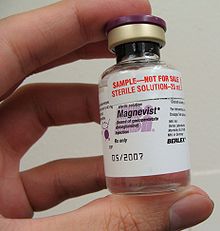- Gadopentetic acid
-
Gadopentetic acid 
Clinical data AHFS/Drugs.com Consumer Drug Information Pregnancy cat. ? Legal status ? Pharmacokinetic data Half-life Distribution half life 12 minutes, elimination half 100 minutes Identifiers CAS number 86050-77-3 
ATC code V08CA01 PubChem CID 55466 DrugBank DB00789 ChemSpider 50087 
UNII RH248G8V27 
KEGG D01707 
ChEBI CHEBI:31797 
ChEMBL CHEMBL1201276 
Chemical data Formula C28H54GdN5O20 SMILES eMolecules & PubChem  (what is this?) (verify)
(what is this?) (verify)Gadopentetic acid is one of the trade names for a gadolinium -based MRI contrast agent, usually administered as a salt of a complex of gadolinium with DTPA (DiethyleneTriaminePentAcetic acid) with the chemical formula A2[Gd(DTPA)]; when cation A is the protonated form of the amino sugar meglumine the salt goes under the name "Gadopentetate dimeglumine". It was described in 1981 and introduced as the first MRI contrast agent in 1987. It is used to assist imaging of blood vessels and of inflamed or diseased tissue where the blood vessels become 'leaky'. It is often used when viewing intracranial lesions with abnormal vascularity or abnormalities in the blood-brain barrier. It is usually injected intravenously. Gd-DTPA is classed as an acyclic, ionic gadolinium contrast medium. Its paramagnetic property reduces the T1 relaxation time (and to some extent the T2 and T2* relaxation times) in NMR, which is the source of its clinical utility.
Marketed as Magnevist by Bayer Schering Pharma, it was the first intravenous contrast agent to become available for clinical use, and is in widespread use around the world. Similar contrast agents are Dotarem (gadoterate) manufactured by Guerbet, MultiHance (gadobenate dimeglumine) and ProHance (gadoteridol) manufactured by Bracco, Omniscan (gadodiamide) manufactured by GE Healthcare, and OptiMARK (gadoversetamide) manufactured by Mallinckrodt.
Gadolinium based agents may cause a toxic reaction known as nephrogenic systemic fibrosis (NSF) in patients with severe kidney problems.[1][2]
Compared to other Gadolinium based MRI contrast agents, Gadopentetate dimeglumine (Gd-DTPA2-) chelates allow delayed Gadolinium enhanced enhanced Magnetic Resonance of Cartilage (dGEMRIC). The unique charge characteristic of this complex allows researchers to inversely measure spin-lattice relaxation times as they are related to the concentration of Proteoglycan aggregates and charged Glycosaminoglycan side chains in articular cartilage. [3][4]
Chemical structure and mode of action
In the complex of Gd3+ and DTPA5- the gadolinium ion is 9-coordinate, surrounded by the 3 nitrogen atoms and 5 oxygen atoms from the carboxylate groups. The ninth coordination site is occupied by a water molecule. This water molecule is labile and exchanges rapidly with water molecules in the immediate vicinity of the gadolinium complex. The gadolinium ion has 7 unpaired electrons with paralell spins and is strongly paramagnetic with a 1S electronic ground state. The chemical shift of the water molecules is affected by proximity to the paramagnetic centre. This alters their MRI properties and enables contrast enhancement to be achieved. [5]
References
- ^ Murphy KJ, Brunberg JA, Cohan RH (1996). "Adverse reactions to gadolinium contrast media: a review of 36 cases". American Journal of Roentgenology 167 (4): 847–849. PMID 8819369.
- ^ H.S. Thomsen, S.K. Morcos and P. Dawson (November 2006). "Is there a causal relation between the administration of gadolinium-based contrast media and the development of nephrogenic systemic fibrosis (NSF)?". Clinical Radiology 61 (11): 905–906. doi:10.1016/j.crad.2006.09.003. PMID 17018301.
- ^ Bashir A, Gray ML, Boutin RD, Burstein D. Glycosaminoglycan in articular cartilage: in vivo assessment with delayed Gd(DTPA)(2-)-enhanced MR imaging. Radiology. Nov 1997;205(2):551-558.
- ^ Bashir A, Gray ML, Hartke J, Burstein D. Nondestructive imaging of human cartilage glycosaminoglycan concentration by MRI. Magn Reson Med. May 1999;41(5):857-865.
- ^ Caravan, Peter; Ellison, Jeffrey J.; McMurry, Thomas J. ; Lauffer, Randall B. (1999). "Gadolinium(III) Chelates as MRI Contrast Agents: Structure, Dynamics, and Applications". Chem. Revs. 99 (9): 2293–2342. doi:10.1021/cr980440x.
External links
- Bayer Healthcare Pharmaceuticals page on Magnevist (for US)
- Bayer Schering Pharma global Magnevist Website
- "Gadopentetate Dimeglumine". Magnetic Resonance—Technology Information Portal. http://www.mr-tip.com/serv1.php?type=db1&dbs=Gadopentetate%20Dimeglumine. Retrieved 2006-03-27.
Contrast media (V08) X-ray and CT Iodinated,
Water solubleNephrotropic,
high osmolarDiatrizoic acid# • Metrizoic acid • Iodamide • Iotalamic acid • Ioxitalamic acid • Ioglicic acid • Acetrizoic acid • Iocarmic acid • Methiodal • DiodoneNephrotropic,
low osmolarHepatotropicIodoxamic acid • Iotroxic acid • Ioglycamic acid • Adipiodone • Iobenzamic acid • Iopanoic acid • Iocetamic acid • Sodium iopodate • Tyropanoic acid • Calcium iopodateIodinated,
Water insolubleEthyl esters of iodised fatty acids • Iopydol • Propyliodone • Iofendylate • LipiodolNon-iodinatedMRI ParamagneticGadolinium-based: Gadobenic acid • Gadobutrol • Gadodiamide • Gadofosveset • Gadolinium • Gadopentetic acid • Gadoteric acid • Gadoteridol • Gadoversetamide • Gadoxetic acid
Other: Ferric ammonium citrate • MangafodipirFerumoxsil • Ferristene • Iron oxide, nanoparticlesOtherPerflubronUltrasound Microspheres of human albumin • Microparticles of galactose • Perflenapent • Microspheres of phospholipids • Sulfur hexafluoride
This pharmacology-related article is a stub. You can help Wikipedia by expanding it.

